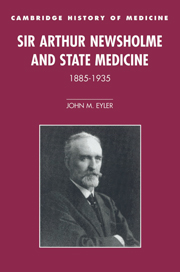Book contents
- Frontmatter
- Contents
- Illustrations
- Preface
- Abbreviations
- PART I THE MEDICAL OFFICER OF HEALTH AND THE LOCAL SANITARY AUTHORITY
- 1 The Medical Officer of Health and his town
- 2 Fact, theory, and the epidemic milieu
- 3 The urban environment and the M.O.H.'s authority
- 4 The municipal hospital and the isolation of acute infectious diseases
- 5 The epidemiology of infected food and the limits of sanitary jurisdiction
- 6 Tuberculosis: Public policy and epidemiology
- PART II NEWSHOLME AT THE LOCAL GOVERNMENT BOARD
- PART III THE OLD WORLD AND THE NEW: NEWSHOLME AS ELDER STATESMAN
- Select bibliography
- Index
- Titles in the series
2 - Fact, theory, and the epidemic milieu
Published online by Cambridge University Press: 04 December 2009
- Frontmatter
- Contents
- Illustrations
- Preface
- Abbreviations
- PART I THE MEDICAL OFFICER OF HEALTH AND THE LOCAL SANITARY AUTHORITY
- 1 The Medical Officer of Health and his town
- 2 Fact, theory, and the epidemic milieu
- 3 The urban environment and the M.O.H.'s authority
- 4 The municipal hospital and the isolation of acute infectious diseases
- 5 The epidemiology of infected food and the limits of sanitary jurisdiction
- 6 Tuberculosis: Public policy and epidemiology
- PART II NEWSHOLME AT THE LOCAL GOVERNMENT BOARD
- PART III THE OLD WORLD AND THE NEW: NEWSHOLME AS ELDER STATESMAN
- Select bibliography
- Index
- Titles in the series
Summary
THE METHODS OF EPIDEMIOLOGY AND THE WORK OF THE M.O.H.
While still a comparatively young Medical Officer of Health, Arthur Newsholme became an authority on vital statistics and an important epidemiologist. His The Elements of Vital Statistics, which first appeared in 1889 shortly after he arrived in Brighton, seems to have been the first practical textbook of statistics for Medical Officers of Health. It was widely used during his career and remained a standard source for many years, appearing in a new edition as late as 1923. As a perusal of Newsholme's bibliography shows, his publications in vital statistics and epidemiology are both numerous and varied. He did intensive local investigations as well as sweeping international comparisons. He studied old scourges like smallpox and typhoid fever as well as diseases that had received little attention from statisticians, such as cancer. He traced epidemics, identified long-term trends in mortality, morbidity, and fertility, and he tried to identify the causes for these changes. We will consider examples of his statistical and epidemiological investigations in several of the following chapters.
I will argue that Newsholme's epidemiology and his administrative work were intimately related. The latter frequently suggested the subjects for the former and often supplied the data. The former provided the direction and credibility for the latter. It was Newsholme's view that “epidemiology is the centre and main spring of all public health work.” That assessment was made in 1918 in the midst of planning the postwar reorganization of the central British health authority, the planning that led to the creation of the Ministry of Health.
- Type
- Chapter
- Information
- Sir Arthur Newsholme and State Medicine, 1885–1935 , pp. 27 - 51Publisher: Cambridge University PressPrint publication year: 1997

